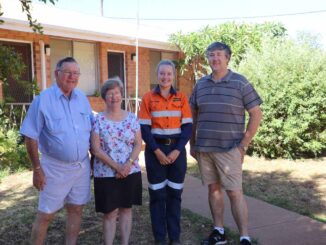
Air quality was the focus of Peak Gold Mines’ (PGM) community information session at the Cobar Bowling & Golf Club last Wednesday night.
The meeting, which also included a site tour for members of the public to see what a vent rise looked like first hand, is one of a number of information sessions that PGM is running in an effort to keep the community updated on their upgrade plans at Great Cobar.
Jonathon Thompson, Environment Group Manager for Aurelia Metals Ltd (which owns PGM) said the information sessions are above and beyond what Peak is required to report to the community however they wanted to be “honest, open and transparent”.
The construction of a vent rise 450m from town (on the slag dump) and the subsequent effects that might have on local air quality was a concern raised by the public at the mine’s previous community consultation meetings.
The vent rise is needed as part of the exploration work to provide ventilation to the mine to maintain a safe working environment (temperature, quality and dust particles).
Air intake vents will bring fresh air in and exhaust vents will remove it.
PGM has advised the vented air may contain particles that include lead and diesel particulates (minute separate particles) and brought in Air Quality Consultant, Judith Cox from ERM, to last week’s meeting to explain the modelling she has developed for the project and how it might affect our air quality.
Ms Cox, who has 20 years of experience as an air quality consultant, gave a detailed presentation explaining different particle sizes, their chemical makeup and the health effects of air particles on humans.
Ms Cox advised that ambient air quality monitoring has not been previously carried out in Cobar; and has only been occurring areas with populations of 20,000 or more since the 1950s. In recent years with changing technology, this however has been expanded to larger regional areas.
Ms Cox’s assessment of the current air quality in Cobar was made using comparisons of data from other regional towns, including Narrabri, which Ms Cox said would be the most similar to Cobar due to having a similar population size, a remote location and Narrabri also has a mining industry.
She also used data collected from vent rise monitoring during exploration and mining.
Ms Cox explained that her modelling was trying to replicate the atmosphere “which is very, very complicated”.
She said air quality is driven by natural events like drought and bushfires and that places like Wagga Wagga have poor air quality due to the large numbers of home wood fires.
As part of her presentation, Ms Cox spoke about the additional monitoring equipment that PGM is installing as part of the project which include a weather station, four dust deposition gauges, two high volume air samplers and a real time dust monitor.
In summary, she said vent rises were required to maintain a safe working environment.
“Data available suggests that current air quality in Cobar is good,” she said.
“Air quality assessment used conservative assumptions for existing air quality.
“Modelling of emission from the Exploration Vent Rise and Mining Vent Rise shows predicted compliance with all relevant assessment criteria,” Ms Cox said.
She said there would only be “a small predicted increase compared with background variation”.
During the bus tour prior to the meeting, PGM general manager Neal Valk showed members of the public the Chesney vent fan at their New Cobar site, which is “basically what we want to build”.
They were also showed the site where the new vent rise would be constructed.

